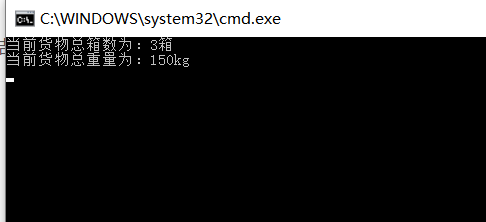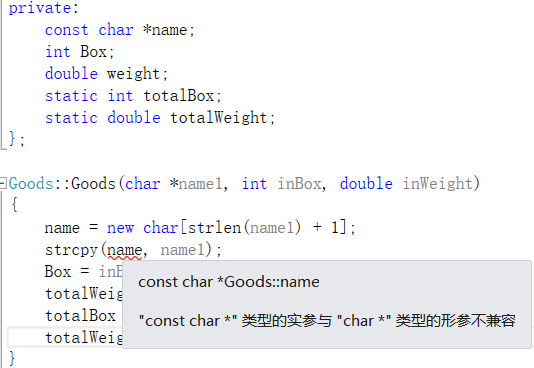The use of static members and constant members in C++
1. Experiment purpose
(1) Learn the use of static members
(2) Learn the use of constant members
(3) Master the initialization of static data members and constant data members
2. Experiment content
(1) A store distributes a The goods are purchased in boxes and sold in boxes. The weight is used as the unit when purchasing and selling. The weight of each box is different. Therefore, the store needs to record the total weight of the goods currently in stock. Now it is required to design a Goods class and use static members to simulate the purchase and sale of goods in the store;
(2) Add a constant data member (goods name) to the above Goods class and initialize the goods name;
(3) Change the previous Rewrite some defined member functions as constant member functions and observe whether all member functions in the class can be set as constant member functions.
3. Experimental steps
(1) Add a header file Goods.h to define the Goods class
#include<iostream>using namespace std;class Goods
{public:
Goods(int inBox, double inWeight);
~Goods(); void Sell(int outBox, double outWeight); void print();private: int Box; double weight; static int totalBox; static double totalWeight;
};
Goods::Goods(int inBox, double inWeight)
{
Box = inBox;
totalWeight = inWeight;
totalBox = totalBox + inBox;
totalWeight = totalWeight = inWeight;
}void Goods::Sell(int outBox, double outWeight) {
totalBox = totalBox - outBox;
totalWeight = totalWeight - outWeight;
}void Goods::print() { cout << "当前货物总箱数为:" << totalBox << "箱" << endl; cout << "当前货物总重量为:" << totalWeight << "kg" << endl;
}
Goods::~Goods()
{
}int Goods::totalBox = 0;double Goods::totalWeight = 0.0; (2) Add a source file Goods.cpp to implement the member function.
(3) Define several Goods class objects in the main program to simulate the process of purchasing and selling. View the running results.
#include"Goods.h"int main()
{
Goods gd(5, 200);
gd.Sell(2, 50);
gd.print();
getchar(); return 0;
}
(4) Add a constant data member const char * name to the Goods class to represent the name of the goods, rewrite the constructor and main program calls, and assign an initial value to the goods name in the member initialization list of the constructor. Recompile and observe the running results.

(5) Rewrite some of the previously defined member functions as constant member functions and observe whether all member functions in the class can be set as constant member functions.

Constant data members cannot update the data members of the object, nor can they call ordinary member functions in the class. The value of data members will never be updated in a constant member function.

Hot AI Tools

Undresser.AI Undress
AI-powered app for creating realistic nude photos

AI Clothes Remover
Online AI tool for removing clothes from photos.

Undress AI Tool
Undress images for free

Clothoff.io
AI clothes remover

Video Face Swap
Swap faces in any video effortlessly with our completely free AI face swap tool!

Hot Article

Hot Tools

Notepad++7.3.1
Easy-to-use and free code editor

SublimeText3 Chinese version
Chinese version, very easy to use

Zend Studio 13.0.1
Powerful PHP integrated development environment

Dreamweaver CS6
Visual web development tools

SublimeText3 Mac version
God-level code editing software (SublimeText3)

Hot Topics
 1662
1662
 14
14
 1419
1419
 52
52
 1311
1311
 25
25
 1261
1261
 29
29
 1234
1234
 24
24
 C# vs. C : History, Evolution, and Future Prospects
Apr 19, 2025 am 12:07 AM
C# vs. C : History, Evolution, and Future Prospects
Apr 19, 2025 am 12:07 AM
The history and evolution of C# and C are unique, and the future prospects are also different. 1.C was invented by BjarneStroustrup in 1983 to introduce object-oriented programming into the C language. Its evolution process includes multiple standardizations, such as C 11 introducing auto keywords and lambda expressions, C 20 introducing concepts and coroutines, and will focus on performance and system-level programming in the future. 2.C# was released by Microsoft in 2000. Combining the advantages of C and Java, its evolution focuses on simplicity and productivity. For example, C#2.0 introduced generics and C#5.0 introduced asynchronous programming, which will focus on developers' productivity and cloud computing in the future.
 Where to write code in vscode
Apr 15, 2025 pm 09:54 PM
Where to write code in vscode
Apr 15, 2025 pm 09:54 PM
Writing code in Visual Studio Code (VSCode) is simple and easy to use. Just install VSCode, create a project, select a language, create a file, write code, save and run it. The advantages of VSCode include cross-platform, free and open source, powerful features, rich extensions, and lightweight and fast.
 Golang and C : Concurrency vs. Raw Speed
Apr 21, 2025 am 12:16 AM
Golang and C : Concurrency vs. Raw Speed
Apr 21, 2025 am 12:16 AM
Golang is better than C in concurrency, while C is better than Golang in raw speed. 1) Golang achieves efficient concurrency through goroutine and channel, which is suitable for handling a large number of concurrent tasks. 2)C Through compiler optimization and standard library, it provides high performance close to hardware, suitable for applications that require extreme optimization.
 The Performance Race: Golang vs. C
Apr 16, 2025 am 12:07 AM
The Performance Race: Golang vs. C
Apr 16, 2025 am 12:07 AM
Golang and C each have their own advantages in performance competitions: 1) Golang is suitable for high concurrency and rapid development, and 2) C provides higher performance and fine-grained control. The selection should be based on project requirements and team technology stack.
 Python vs. C : Learning Curves and Ease of Use
Apr 19, 2025 am 12:20 AM
Python vs. C : Learning Curves and Ease of Use
Apr 19, 2025 am 12:20 AM
Python is easier to learn and use, while C is more powerful but complex. 1. Python syntax is concise and suitable for beginners. Dynamic typing and automatic memory management make it easy to use, but may cause runtime errors. 2.C provides low-level control and advanced features, suitable for high-performance applications, but has a high learning threshold and requires manual memory and type safety management.
 Golang and C : The Trade-offs in Performance
Apr 17, 2025 am 12:18 AM
Golang and C : The Trade-offs in Performance
Apr 17, 2025 am 12:18 AM
The performance differences between Golang and C are mainly reflected in memory management, compilation optimization and runtime efficiency. 1) Golang's garbage collection mechanism is convenient but may affect performance, 2) C's manual memory management and compiler optimization are more efficient in recursive computing.
 Golang vs. C : Performance and Speed Comparison
Apr 21, 2025 am 12:13 AM
Golang vs. C : Performance and Speed Comparison
Apr 21, 2025 am 12:13 AM
Golang is suitable for rapid development and concurrent scenarios, and C is suitable for scenarios where extreme performance and low-level control are required. 1) Golang improves performance through garbage collection and concurrency mechanisms, and is suitable for high-concurrency Web service development. 2) C achieves the ultimate performance through manual memory management and compiler optimization, and is suitable for embedded system development.
 How to execute code with vscode
Apr 15, 2025 pm 09:51 PM
How to execute code with vscode
Apr 15, 2025 pm 09:51 PM
Executing code in VS Code only takes six steps: 1. Open the project; 2. Create and write the code file; 3. Open the terminal; 4. Navigate to the project directory; 5. Execute the code with the appropriate commands; 6. View the output.




